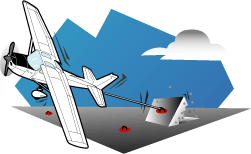 |
||||||||
| Issue Number 275 |
July
2002
|
|||||||
|
P.O. Box 189, Moffett Field, CA 94035-0189 |
||||||||
|
|
||||||||
 |
||||||||
| Issue Number 275 |
July
2002
|
|||||||
|
P.O. Box 189, Moffett Field, CA 94035-0189 |
||||||||
|
|
||||||||
![]()
Self-imposed goals and peer pressure can lead to a troublesome twist on the "get-home-itis" dilemma. After a long winter, the desire to get away to a vacation destination or a fly-in event can offer as many pitfalls for the unprepared as the well-documented urge to "get home."
We've all got a compelling reason to "get there," but cutting corners or pushing prudent limits is more likely to lead to a compelling story for CALLBACK... or the NTSB.


A well-written ASRS report details how a Cessna pilot on a first long cross-country experienced an unexpected delay in departing. "Getting there" became an issue, and one of the links in a fateful chain of events.
Fortunately, neither I nor the airplane was hurt. I began inspecting the airplane to find out what went wrong, and soon discovered the problem the tanks were empty. My forced landing on [a] highway... was not the result of some mechanical failure that was beyond my control, but rather had been caused by me alone.
Here is my analysis of what went wrong:
The Preflight - Getting out [of the plane] to check the fuel, another pilot offered to check it for me. I consented. This was my first and biggest mistake...
The Assumption - I made a major mistake by assuming that the fuel order had been filled.
Time - ...I was cognizant of the fact that I would be departing later than planned. Getting there should never influence the preparations for a flight.
Fuel Burn - Before this experience, I relied solely on my time and fuel burn calculations, trusting the accuracy of my calculations much more than the fuel gauges. My new policy is to trust whichever one says that I have the least amount of fuel, and act accordingly...
This experience... proved the importance of being able to stay calm and fly the plane. I also received a firsthand lesson of how important it is to utilize [the services of] ATC... The calm voice of the Approach Controller directing me toward the airport was invaluable at the height of this emergency.
I think the most important lesson that I gained from this experience is the importance of checking... and double-checking every aspect of the flight.
We thank our reporter for sharing an experience that may help other pilots "get (all the way) there.
![]()
Many pilots have experienced the same self-imposed pressures that led the author of this ASRS report to get in a bind where the binders couldn't help. Fatigue was also a factor when this reporter paid more attention to the voice saying, "Get there," than to the one screaming, "Go around."
- Poor approaches lead to poor landings.
- If it doesn't feel right, there's usually a reason.
- Never ignore that voice in the back of your mind telling you something is wrong.
Responsibility? 100% mine. If I wasn't comfortable with the shorter runway, I should have refused the landing clearance on Runway 28R. [I] need more practice.

Another aspect of the desire to "get there" is the perceived need to "get going." When time is critical, that's the time to be especially vigilant and mindful of the task at hand. Rushing preflight procedures or checklists is more likely to lead to an embarrassing delay than an on-time departure.
 When
the pilot-poet John Gillespie Magee "danced the skies on laughter-silvered
wings," he was perhaps more vigilant in his preflight than the
pilots who submitted these ASRS Reports. We thank them for pointing
out two types of incidents that are all too common when pilots get
rushed. If you don't slip all the "bonds," you'll
never make it to the "dance."
When
the pilot-poet John Gillespie Magee "danced the skies on laughter-silvered
wings," he was perhaps more vigilant in his preflight than the
pilots who submitted these ASRS Reports. We thank them for pointing
out two types of incidents that are all too common when pilots get
rushed. If you don't slip all the "bonds," you'll
never make it to the "dance."
 uired
to arrive at my destination prior to closing, I rushed the preflight
to depart ASAP. Because of this, I overlooked one of the three tie-down
ropes. When I began to taxi, the airplane moved slightly before
coming to a stop. Believing my wheel had stuck in a pothole I increased
power to 1700 rpm. Then I looked back and saw the tie-down rope.
uired
to arrive at my destination prior to closing, I rushed the preflight
to depart ASAP. Because of this, I overlooked one of the three tie-down
ropes. When I began to taxi, the airplane moved slightly before
coming to a stop. Believing my wheel had stuck in a pothole I increased
power to 1700 rpm. Then I looked back and saw the tie-down rope.
![]()
Two air carrier flight crews rushed to meet the schedule and were not alert enough to catch a "change in plans."
![]()
Occasionally, dramatic footage of an aviation accident is the lead story on the network news, but there can also be dramatic images in ASRS reports. In the case of two runway incursions reported to the ASRS, haste was again a factor in the flawed decisions made by a controller trying to expedite an aircraft movement, and a flight crew that was running late. Both of these incidents came within 25 feet of being network news.
| ASRS Recently Issued Alerts On... |
|---|
| EMB-145 pitch trim failure |
| Airway similar-sounding fixes |
| B767 wake turbulence separation incident |
| Runway incursion at a major Southern airport |
| Lack of tower obstruction markings on an approach chart |
|
May
2002 Report Intake
|
|
|---|---|
| Air Carrier/Air Taxi Pilots |
2,112
|
| General Aviation Pilots |
811
|
| Controllers |
66
|
| Cabin/Mechanics/Military/Other |
135
|
| TOTAL |
3,124
|